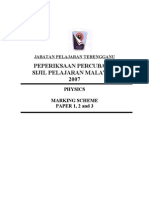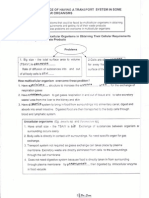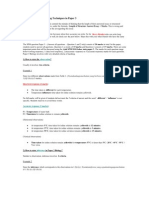3.0 Module Q&A
3.0 Module Q&A
Uploaded by
hernaniabdullahCopyright:
Available Formats
3.0 Module Q&A
3.0 Module Q&A
Uploaded by
hernaniabdullahOriginal Description:
Copyright
Available Formats
Share this document
Did you find this document useful?
Is this content inappropriate?
Copyright:
Available Formats
3.0 Module Q&A
3.0 Module Q&A
Uploaded by
hernaniabdullahCopyright:
Available Formats
TUTORIAL 3.
0:PERIODIC TABLE
1. The table shows the group and period of the elements P, Q, R, S and T.
Element Period Group
P 2 15
Q 2 18
R 3 1
S 4 17
T 4 16
(a) Write the electronic configuration for each of the element.
(b) Write the electronic configuration for P3−, R+ and S −.
(c) State the block for each element.
Solution:
1. (a) P: 1s2 2s2 2p3
Q: 1s2 2s2 2p6
R: 1s2 2s2 2p6 3s1
S: 1s2 2s2 2p6 3s2 3p6 3d10 4s2 4p5
T: 1s2 2s2 2p6 3s2 3p6 3d10 4s2 4p4
(b) P3- : 1s2 2s2 2p6
R+ : 1s2 2s2 2p6
S - : 1s2 2s2 2p6 3s2 3p6 3d10 4s2 4p6
(c) s block - R
p block - P, Q, S, T
2. State the period, group and block for each element:
A: 1s2 2s2 2p6 3s2 3p6
B: 1s2 2s2 2p6 3s2 3p6 3d10 4s2 4p5
C: 1s2 2s2 2p6 3s2 3p6 4s2
D: 1s2 2s2 2p6 3s2 3p6 3d3 4s2
E: 1s2 2s2 2p6 3s2 3p6 3d10 4s2 4p6
Chemistry Unit KMPk 2021 34 Prepared by JK Module 2021
TUTORIAL 3.0:PERIODIC TABLE
Solution:
2.
Elements Period Group Block
A 3 18 P
B 4 17 P
C 4 2 S
D 4 5 d
E 4 18 P
3. The figure shows the location of elements A, B, C, D and E in the periodic table.
A B C D
E
(a) State how the elements A to E are arranged.
(b) Why are elements B and E in the same group?
(c) Why are elements B and C in the same period?
(d) Which of the elements are metal?
Solution:
3. (a) Elements are arranged in the order of increasing proton number.
(b) Both elements B and E have the same number of valence electrons.
(c) Both elements B and C have the same principal quantum number, n.
(d) Metals: A, B, E
4. Explain the variation in the ionic radii across a period .
Chemistry Unit KMPk 2021 35 Prepared by JK Module 2021
TUTORIAL 3.0:PERIODIC TABLE
Solution:
4. Across a period, ionic radii decreases because the effective nuclear charge
increases due to the increase in proton number. The charge “felt” by the
outermost electron increases, and the electrons are pulled closer to the nucleus
which makes the ionic radii smaller.
PSPM 08/09 QUE 10
Students were asked to explain the trend observed in the ionic radii of elements
in the second period.
Student must be able to explain as below:-
• Ionic radius decreases from Li+ to B3+ because the effective nuclear charge
increases as proton number increases within the same shell (n=1)
• Big increase in radius from B3+ to N3- because of increase in the number of shell
n=1 to n=2.
• Ionic radius decreases from N3- to F- because the effective nuclear charge
increases as proton number increases within the same shell (n=2)
• All cation species have smaller radius than anions because cations have one
lesser shell
5. Cations Mg2+, Al3+, Na+, Si4+ are isoelectronic with the electronic configuration,
1s2 2s2 2p6. Arrange the cations in order of increasing ionic radius. Explain.
Solution:
5. Si4+ < Al3+ < Mg2+ < Na+
Increasing ionic radius
Moving from Na to Si, the effective nuclear charge increases as the number of
protons in the nucleus increases. The electrons are attracted more strongly to the
increased positive nucleus, thus reducing the total ionic radius.
6. Removal and addition of electron results in change of atomic radii.
Species Na Na+ Cl Cl-
Radius/nm 0.156 0.095 0.099 0.181
Chemistry Unit KMPk 2021 36 Prepared by JK Module 2021
TUTORIAL 3.0:PERIODIC TABLE
Explain the difference in radius between the ions and their respective neutral
atoms.
Solution:
6. Na+ < Na.
The number of electrons in Na+ ion is 10 and Na atom is 11, but the number of
protons is the same (11 protons). The attraction between the nucleus and the
electrons in Na+ is stronger.
Cl > Cl.
Cl- ion has more electron than its neutral atoms as it gains electron during its
formation. The greater electron-electron repulsions in Cl- ion caused the
electrons to spread out and experience less attraction from the nucleus.
7. (a) What is meant by the first and second ionisation energies?
(b) State the factors that affect the ionisation energy of an atom.
Solution:
7. (a) The first ionisation energy of an atom is the energy required to remove
one mole electron from one mole of gaseous atom to produce positive
ion.
Energy + X(g) X +(g) + e-
The second ionisation energy of an atom is the energy required to
remove one mole electron from one mole positive ion in the gaseous
state.
Energy + X +(g) X 2+(g) + e-
(b) Three main factors that affect the ionisation energy of an atom :
i. Size
As the distance from the outermost electron to the positive
nucleus increases, the attraction of the nucleus for electron
decreases. The ionisation energy gets smaller as the atomic
radius increases.
Chemistry Unit KMPk 2021 37 Prepared by JK Module 2021
TUTORIAL 3.0:PERIODIC TABLE
ii. Effective nuclear charge
More positive nucleus will have greater attraction for the
valence electrons and the ionisation energy of an atom will be
greater.
iii. Shielding effect
The electrons in the inner shell shield the valence electrons from the
positively charged nucleus. The valence electrons will be less firmly held. The
more shells between the valence electrons and the nucleus, the more will
be the screening effect. Hence, the lower will be the ionisation energy of the
atom
8. The table shows the successive ionisation energies (IE / kJ mol-1) for elements J,
K, L, M and N.
Element IE1 IE2 IE3 IE4 IE5
J 801 2430 3660 25000 32820
K 1086 2350 4620 6200 38000
L 786 1580 3230 4360 16000
M 418 3052 4410 5900 8000
N 738 1450 7730 10500 13600
(a) Explain which element will form ion with the charge of +1.
(b) i. Choose two elements which belong to the same group.
ii. Explain the difference in the first ionization energy values for the
two elements.
(c) Determine the group for element L.
Solution:
8.
Element IE2 IE3 IE4 IE5
s
IE1 IE2 IE3 IE4
J 3.03 1.51 6.83 1.31
K 2.16 1.97 1.34 6.13
Chemistry Unit KMPk 2021 38 Prepared by JK Module 2021
TUTORIAL 3.0:PERIODIC TABLE
L 2.01 2.04 1.35 3.67
M 7.30 1.44 1.34 1.36
N 1.96 5.33 1.36 1.30
(a) M, because the ratio of IE2 to IE1 is the highest
(b) i. Elements K and L
ii. The first ionisation energy for element L is lower than K because L
is in lower period than K. The atomic size of L is bigger and the
screening effect is greater than K. Thus, the attraction of
nucleus on the outer electron is weaker.
(c) Group 14
9. Ionisation energy for nitrogen atom is greater than that of oxygen atom but the
ionisation energy for N+ is lower than that of O+. Explain.
Solution:
9. 7N : 1s2 2s2 2p3 (Stability of the half-filled 2p orbitals)
8O : 1s2 2s2 2p4
O+ : 1s2 2s2 2p3 (Stability of the half-filled 2p orbitals)
N+ : 1s2 2s2 2p2
10. Among the elements magnesium, sodium and silicon, which has the highest
second ionisation energy? Explain.
Solution:
10. 11Na : 1s2 2s2 2p6 3s1
12Mg : 1s2 2s2 2p6 3s2
14Si : 1s2 2s2 2p6 3s2 3p2
Sodium has the highest second ionisation energy because the second electron to
be removed from the ion comes from the full-filled 2p orbitals
Chemistry Unit KMPk 2021 39 Prepared by JK Module 2021
TUTORIAL 3.0:PERIODIC TABLE
11. The table shows the electronic configuration of elements W, X, and Y.
Element Electronic configuration
W [Ne]3s1
X [Ne] 3s23p4
Y [Ar]4s2
(a) Explain
i. the difference in the first ionisation energy between elements W
and X
ii. the difference in ionic radius between X 2- and Y 2+
(b) Write the molecular formula of the oxide formed when Y reacts with
oxygen and state whether it is acidic, basic or amphoteric.
Solution:
11. (a) i. W: [Ne] 3s1
X: [Ne] 3s23p4
The first ionisation energy for W is lower than X because across a
period, the valence electron is more difficult to remove as the
atomic radius decrease.
ii. X2- : [Ne] 3s23p6
Y2+ : [Ar]
The ionic radius of Y2+ is smaller than X2 because the effective
nuclear charge of Y2+ is higher than X2- .
Chemistry Unit KMPk 2021 40 Prepared by JK Module 2021
TUTORIAL 3.0:PERIODIC TABLE
12. The graph shows the variation of ionisation energies for element Z.
log ionisation energy
X
X
X
X
X
X
X
X
X
X
X
X
X
(a) State the group and period forofelement
No. electron Z.
removed
(b) Why a higher energy is needed to remove the fourth electron?
(c) Explain how the atomic radius of Z changes when an electron is removed.
(d) State the change in the atomic radius of Z when an electron is added.
(e) State the most stable oxidation number of element Z.
Solution:
12. (a) Group 13, period 3
(b) Because the fourth electron is from the inner shell (close to the nucleus)
(c) Atomic radius decreases
(d) Atomic radius increases
(e) +3
13. (a) Define electronegativity.
(b) Explain qualitatively the variation of electronegativity across a period and
down a group.
Solution:
13. (a) Electronegativity is the relative tendency of an atom to attract
electrons to itself when chemically combined with another atom.
Chemistry Unit KMPk 2021 41 Prepared by JK Module 2021
TUTORIAL 3.0:PERIODIC TABLE
(b) Electronegativity increases across a period
Due to the increasing positive charge on the nucleus in
combination with the decrease in atomic radius.
Electronegativity decreases down a group
Although the positive charge on the nucleus increases, this is more than
the offset by the increase in the atomic radius and the additional
screening effect of the extra electron shells.
14. Elements Na, Al, P, Cl and Ar are in period 3. Select the element that
(a) has the highest melting point.
(b) forms diatomic molecular gases.
(c) has the highest second ionisation energy.
(d) forms amphoteric oxide and write the equation to show its amphoteric
behaviour.
Solution:
14. (a) Al
(b) Cl2
(c) Na
(d) Al
As a base:
Al2O3(s) + 6HCl(aq) 2 AlCl3(aq) + 3H2O(l)
As an acid:
Al2O3(s) + 2NaOH(aq) + 3H2O(l) 2 NaAl(OH)4(aq)
15. (a) Classify the following oxides as basic, acidic or amphoteric.
Al2O3, SiO2, MgO, P4O10, SO3, Na2O, Cl2O
(b) Write the equations for the reaction between the following oxides with
water.
i. Na2O
ii. SO3
iii. Al2O3
Chemistry Unit KMPk 2021 42 Prepared by JK Module 2021
TUTORIAL 3.0:PERIODIC TABLE
Solution:
15. (a) Basic oxide: MgO, Na2O
Acidic oxide: SiO2, P4O10, SO3, Cl2O
Amphoteric oxide: Al2O3
(b) i. Na2O(s) + H2O(l) 2 NaOH(aq)
ii. SO3(g) + H2O(l) H2SO4(aq)
iii. As a base:
Al2O3(s) + 6 HCl(aq) 2 AlCl3(aq) + 3 H2O(l)
As an acid:
Al2O3(s) + 2 NaOH(aq) + 3 H2O(l) 2 NaAl(OH)4(aq)
16. The table shows the melting point of the elements in period 3.
Element Na Mg Al Si P S Cl Ar
Melting point 98 650 660 1423 44 120 -101 -189
(oC)
Explain the variation in melting points of the elements in terms of the structure
and the intermolecular forces.
Solution:
16. (a) Melting point increases from Na to Al. Strength of the metallic bonding
is proportional to the number of valence electrons. Valence electrons
of Al, Mg, Na are 3, 2 and 1 respectively.
Si has the highest melting point. It has gigantic molecular colavent
structure. Each Si is tetrahedrally covalent bonded to four other Si atoms
infinitely.
P, S, Cl and Ar have low melting points. Only weak van der Waals
forces are present between these molecules/atom. P, S and Cl have
simple molecular structures while Ar exists as monoatom. van der Waals
forces increase as the size of molecule/atom increases.
Size of S8 > P4 > Cl2 > Ar
Order of increasing melting points: Si > Al > Mg > Na > S8 > P4 > Cl2 > Ar
Chemistry Unit KMPk 2021 43 Prepared by JK Module 2021
TUTORIAL 3.0:PERIODIC TABLE
Objective Questions
1. Identify the element with the highest melting point.
A Al
B Mg
C Na
D Si
2. Which of the following groups contains a basic, an amphoteric and an acidic
oxide?
E SiO2, SO3, Cl2
F MgO, Al2O3, SO3
G Na2O, SiO2, P4O10
H MgO, Al2O3, Na2O
3. Which of the following arrangements shows the order of increasing ionic radius?
A K+ <Cl- <S2- <P3-
B K+ <P3- <S2- <Cl-
C P3- <S2- <Cl- <P3-
D Cl- <S2- <P3- <P3-
4. The table shows the first, second, third and fourth ionisation energies of elements
Y and Z.
Element Ionisation Energy / kJ mol-1
First Second Third Fourth
Y 494 1450 6940 9540
Z 418 1390 5800 7600
Which of the following statements about Y and Z is/are true?
I The size of Y atom is smaller than that of Z atom.
II Both elements can form ions with +2 charge.
Chemistry Unit KMPk 2021 44 Prepared by JK Module 2021
TUTORIAL 3.0:PERIODIC TABLE
III Both elements belong to the same group.
5. The atomic radius of the d-block elements do not change significantly because
I the effective nuclear charge do not change much.
II the electrons are added into an inner d orbitals.
III the screening effect increases
6. Going down a group in the periodic table
I electronegativity decreases.
II the metallic properties increases.
III ease of cation formation increases.
7. The size of Na+ > Mg2+ > Al3+. Which of the followings explain(s) this trend?
I Effective nuclear charge increases.
II The number of electrons are the same but the number of protons
increases.
III The number of electrons and protons increases.
8. The graph shows all the successive ionisation energies of an element P.
Ionisation energy
X
X
X
X X
X
X
X
X
X
X X
X
X
X X
No. of electrons removed
Choose the correct statement(s)
I P is expected to form an basic oxide.
II P is found in the third period of the periodic table.
Chemistry Unit KMPk 2021 45 Prepared by JK Module 2021
TUTORIAL 3.0:PERIODIC TABLE
III The electronic configuration of P is 1s2 2s2 2p6 3s2 3p4.
Answer: 1. D 2. B. 3. A 4. D 5. B 6. D 7. B 8. C
Chemistry Unit KMPk 2021 46 Prepared by JK Module 2021
You might also like
- Tutorial Sains ComputerDocument25 pagesTutorial Sains ComputerAliff Haiqal Bin Aziz L1DP11No ratings yet
- M Tan Theta NotesDocument1 pageM Tan Theta NotesOllie FryNo ratings yet
- 2.4 Bahasa Inggeris Skema Kertas 2 Set BDocument5 pages2.4 Bahasa Inggeris Skema Kertas 2 Set BWnhannan Mohamad67% (3)
- Pattern C5 Vectors - SM025 - 2019 2020Document17 pagesPattern C5 Vectors - SM025 - 2019 2020NUR BATRISYIA AMALYANo ratings yet
- 05 Extra Problems Recap KEYDocument5 pages05 Extra Problems Recap KEYUday Prakash SahuNo ratings yet
- The RDKit Book - The RDKit 2020.03.1 Documentation PDFDocument23 pagesThe RDKit Book - The RDKit 2020.03.1 Documentation PDFMatías AlemánNo ratings yet
- 2 1 B & D TUTORIAL QUESTION Design A Solution ANSWER SCHEMEDocument45 pages2 1 B & D TUTORIAL QUESTION Design A Solution ANSWER SCHEME2022461692No ratings yet
- Reading Part 2Document14 pagesReading Part 2Nur HafezaNo ratings yet
- Sample Questions and Answers For Paper 3 Section B1Document10 pagesSample Questions and Answers For Paper 3 Section B1Adsham100% (3)
- 1.0 Computer System 1.3 Information Coding SchemeDocument6 pages1.0 Computer System 1.3 Information Coding SchemeMukhriz ShahNo ratings yet
- Modern Math Form 4 (Mind Map)Document11 pagesModern Math Form 4 (Mind Map)Farieysha Binti Rohzi.No ratings yet
- Terangganu-Answer Physics P2-Trial SPM 2007Document15 pagesTerangganu-Answer Physics P2-Trial SPM 2007kamalharmoza100% (1)
- 5 The Effects of Hypotonic, Hypertonic and Isotonic Solutions On Mustard GreenDocument2 pages5 The Effects of Hypotonic, Hypertonic and Isotonic Solutions On Mustard GreenJeevanKarthiresanNo ratings yet
- Biology Form 5 Experiment ListDocument17 pagesBiology Form 5 Experiment ListLin Fadzlin0% (3)
- Bab 07 - ElektrikDocument39 pagesBab 07 - ElektrikAl Nazuris100% (2)
- C01 Add Maths Answers Form 4 PDFDocument38 pagesC01 Add Maths Answers Form 4 PDFLee Sun TaiNo ratings yet
- Teknik Menjawab Kimia 3 SPM...Document31 pagesTeknik Menjawab Kimia 3 SPM...Aini AliNo ratings yet
- Bab 6 Cahaya (K2-Skema)Document28 pagesBab 6 Cahaya (K2-Skema)Shaavitaa naaidu MurugaiahNo ratings yet
- Latihan Fizik 7.08Document13 pagesLatihan Fizik 7.08khalil100% (1)
- SKEMA - SOALAN ALA FORMAT PSPM I Set 1 SK015 2020Document7 pagesSKEMA - SOALAN ALA FORMAT PSPM I Set 1 SK015 2020MOHAMAD ARMAN AZMENo ratings yet
- Paper 3 QuestionDocument8 pagesPaper 3 QuestionNoridaAnisNo ratings yet
- 6 ElectrochemistryDocument24 pages6 ElectrochemistryMThana BalanNo ratings yet
- Answers To Inheritance Questions From Solutions SPM Biology BookDocument4 pagesAnswers To Inheritance Questions From Solutions SPM Biology BookCheah Foo KitNo ratings yet
- Jawapan Bio-Score Bab 1 (Form 5)Document45 pagesJawapan Bio-Score Bab 1 (Form 5)azamsensei94% (32)
- SPM BiologyDocument4 pagesSPM BiologyLysandra Lin Sang100% (1)
- Biology SPM 2004 Paper 3Document6 pagesBiology SPM 2004 Paper 3Sean0% (3)
- Peka Physics Form 4Document12 pagesPeka Physics Form 4hasl arbNo ratings yet
- Chapter 6 Quantum Physics StudentDocument3 pagesChapter 6 Quantum Physics StudentKhairul AznizamNo ratings yet
- PHY098 Problem Solving Skill Assignment GP1 S51Document11 pagesPHY098 Problem Solving Skill Assignment GP1 S51Harith HaikalNo ratings yet
- Written By: MR Chew Sensei Estimate Time Complete: 10 PeriodsDocument28 pagesWritten By: MR Chew Sensei Estimate Time Complete: 10 PeriodsHappy KingNo ratings yet
- Probability DistributionDocument21 pagesProbability DistributionTee Pei LengNo ratings yet
- Amali Wajib Soalan 2 F4-BiologiDocument8 pagesAmali Wajib Soalan 2 F4-Biologiputri_latifahNo ratings yet
- Trial Terengganu SPM 2014 Physics K1 K2 K3 Skema PDFDocument16 pagesTrial Terengganu SPM 2014 Physics K1 K2 K3 Skema PDFamadkacakNo ratings yet
- Rajah 1 Menunjukkan Struktur Utama Membran Plasma.: Ulangkaji Topik Tingkatan 4 Biologi Pergerakan Bahan Mrentasi MembranDocument21 pagesRajah 1 Menunjukkan Struktur Utama Membran Plasma.: Ulangkaji Topik Tingkatan 4 Biologi Pergerakan Bahan Mrentasi MembranHerdawati HamdanNo ratings yet
- Paper 2 Bah ADocument13 pagesPaper 2 Bah AHamidah MA50% (2)
- 294 Latihan Intensif PT3 2019 Sains PDFDocument23 pages294 Latihan Intensif PT3 2019 Sains PDFNorulfarrah binti Jaafar Teb3092No ratings yet
- Chapter 2 (Answer)Document17 pagesChapter 2 (Answer)najibahNo ratings yet
- Compilation of Experiments Form 4Document13 pagesCompilation of Experiments Form 4Marzila MohamedNo ratings yet
- Physics SPM 2003Document4 pagesPhysics SPM 2003Joanne Cheah100% (1)
- Sem1 Unit1 MatterDocument9 pagesSem1 Unit1 Mattershehdilanun100% (2)
- Experiment 2: Archimedes' Principle: ObjectiveDocument2 pagesExperiment 2: Archimedes' Principle: Objective1031 NakiudinNo ratings yet
- Field Trip To To Malacca CityDocument3 pagesField Trip To To Malacca CityMohamad Azfierol FerolNo ratings yet
- Physics P1,2,3 Melaka 08 SkemaDocument13 pagesPhysics P1,2,3 Melaka 08 SkemaMohd Khairul Anuar100% (4)
- Chapter 16 OH LaNunDocument7 pagesChapter 16 OH LaNunshehdilanun100% (1)
- Bahagian BDocument6 pagesBahagian BNik ZakiahNo ratings yet
- 2022 Selangor Chemistry K2 Set - 3 JawapanDocument13 pages2022 Selangor Chemistry K2 Set - 3 JawapanSim Yen ChohNo ratings yet
- Biology Form 4 Paper 3 Marking SchemeDocument7 pagesBiology Form 4 Paper 3 Marking SchemeLAUEELANGNo ratings yet
- Perak-Answer Physics-Trial SPM 2008Document21 pagesPerak-Answer Physics-Trial SPM 2008kamalharmoza50% (2)
- DC024 TutorialDocument105 pagesDC024 TutorialazmiahNo ratings yet
- Soalan Halus Struktur Atom PDFDocument30 pagesSoalan Halus Struktur Atom PDFNur Irdina HaniNo ratings yet
- Chemistry AssignmentDocument20 pagesChemistry AssignmentNurul SarahanisNo ratings yet
- 2022 H1 Chemistry Dec Revision Book - Question - FinalDocument42 pages2022 H1 Chemistry Dec Revision Book - Question - Final2022 BALAKRISHNAN ADHITHINo ratings yet
- Periodic Table-1Document2 pagesPeriodic Table-1Gurmaan SinghNo ratings yet
- Sem1 Unit4 Periodic TableDocument10 pagesSem1 Unit4 Periodic Tableshehdilanun0% (1)
- Atomic StructureDocument30 pagesAtomic Structurenaeem mushtaqNo ratings yet
- Chemistry Assignment 3 Class 11Document4 pagesChemistry Assignment 3 Class 11Nayan ShahNo ratings yet
- Unit 3Document7 pagesUnit 3twinkleparmar0064No ratings yet
- Wa0001Document81 pagesWa0001Burhan ButtNo ratings yet
- Electron Configuration and Chemical PeriodicityDocument38 pagesElectron Configuration and Chemical Periodicitypeterpaul_1211No ratings yet
- 2nd Sem Ass ChemDocument5 pages2nd Sem Ass Chembekanmusic05No ratings yet
- Chapter 3.0: Periodic TableDocument3 pagesChapter 3.0: Periodic TablehernaniabdullahNo ratings yet
- Chapter 3 - Periodic Table - QDocument4 pagesChapter 3 - Periodic Table - QhernaniabdullahNo ratings yet
- Group 14 ElementsDocument20 pagesGroup 14 Elementshernaniabdullah0% (1)
- Group 17Document13 pagesGroup 17hernaniabdullah100% (1)
- 2 Number+Patterns+and+SequencesDocument14 pages2 Number+Patterns+and+SequencesbrandontanNo ratings yet
- Silo - Tips - Electron Configurations Isoelectronic Elements Ionization Reactions Chemistry 11Document30 pagesSilo - Tips - Electron Configurations Isoelectronic Elements Ionization Reactions Chemistry 11Shiza SajidNo ratings yet
- Chapter 3 Metals and NonmetalsDocument37 pagesChapter 3 Metals and NonmetalsVibi VibesNo ratings yet
- Chem 112 Week 11 20 by KuyajovertDocument25 pagesChem 112 Week 11 20 by KuyajovertRusvelt Gascon Petrolia100% (2)
- Grade-11 General-Chemistry1 Q2 Wk2 GLAKDocument16 pagesGrade-11 General-Chemistry1 Q2 Wk2 GLAKfeihtwollip3No ratings yet
- Honors Biology Midterm Study GuideDocument17 pagesHonors Biology Midterm Study GuideEmilyNo ratings yet
- WGU C451GNC21NC1 Integrated Natural Sciences Module 1-10Document38 pagesWGU C451GNC21NC1 Integrated Natural Sciences Module 1-10sdwewNo ratings yet
- Physics Semiconductors Project PDFDocument25 pagesPhysics Semiconductors Project PDFAman BindNo ratings yet
- 3.1.1 Study - Electrons & OrbitalsDocument4 pages3.1.1 Study - Electrons & OrbitalsOSCAR SUY-PEREZNo ratings yet
- Jee M A PDFDocument54 pagesJee M A PDFVarun UpadhyayNo ratings yet
- Polarity of MoleculesDocument85 pagesPolarity of MoleculesAislinn Sheen AcasioNo ratings yet
- Chemical BondingDocument2 pagesChemical BondingOwais Siddiqui IX-M-ANo ratings yet
- Bonding and PropertiesDocument17 pagesBonding and PropertiesAdaNo ratings yet
- 6 Intrinsic Semiconductor-1Document12 pages6 Intrinsic Semiconductor-1api-462620165No ratings yet
- Notes2 Unit1Document18 pagesNotes2 Unit1arun iyer BitcoinminerandmathematicianNo ratings yet
- Adieu Class IX - Welcome Class XDocument8 pagesAdieu Class IX - Welcome Class XAnanthakrishnan Tinneveli VNo ratings yet
- MCQ On The Periodic TableDocument21 pagesMCQ On The Periodic TableIsabella EhizomohNo ratings yet
- 8.3: Covalent Bonding: Lewis StructuresDocument8 pages8.3: Covalent Bonding: Lewis StructuresHarshal BandkarNo ratings yet
- Unit - IV Semiconductor Physics: Prepared by Dr. T. KARTHICK, SASTRA Deemed UniversityDocument21 pagesUnit - IV Semiconductor Physics: Prepared by Dr. T. KARTHICK, SASTRA Deemed UniversityMamidi Satya narayana100% (1)
- A A Chemistry Model Exam 2012Document13 pagesA A Chemistry Model Exam 2012Kerod MohamedNo ratings yet
- Coloring The Periodic Table FamiliesDocument13 pagesColoring The Periodic Table Familiesjacquetayar04No ratings yet
- 01 Atomic StructureDocument49 pages01 Atomic StructurePranav PrasadNo ratings yet
- C Physical Properties of Elements and Semiconductors: HapterDocument96 pagesC Physical Properties of Elements and Semiconductors: HapterSoni Mishra Tiwari100% (1)
- Valence Electrons and Valency of An ElementDocument5 pagesValence Electrons and Valency of An ElementManickam GnanashekaranNo ratings yet
- Third Form Chemistry Packet #2Document11 pagesThird Form Chemistry Packet #2Lizbeth ChiNo ratings yet
- MSE 102 Ch02 - 1Document70 pagesMSE 102 Ch02 - 1Mohammed AlbkiliNo ratings yet
- Atomic Structure Lesson PlanDocument4 pagesAtomic Structure Lesson PlanGen Li Togy0% (1)
- Electronics Device PDFDocument38 pagesElectronics Device PDFFariz Azhar AbdillahNo ratings yet
- HydrocarbonsDocument80 pagesHydrocarbonsina stanevaNo ratings yet
- Wa0014.Document23 pagesWa0014.vignaanacademyNo ratings yet






























































































